
Success with Sweet Peas
 Sweet peas have a long and fascinating horticultural history. In 1699, a botanizing monk, Father Cupani first harvested sweet peas in the wild on an island off the coast of Sicily. In the 19th century, an Englishman named Eckford began hybridizing and selecting sweet peas, introducing larger varieties in a wider range of colors. These "grandifloras" were widely acclaimed as cut flowers, and they are the type of sweet peas we now call "old-fashioned" or "heirloom."
Sweet peas have a long and fascinating horticultural history. In 1699, a botanizing monk, Father Cupani first harvested sweet peas in the wild on an island off the coast of Sicily. In the 19th century, an Englishman named Eckford began hybridizing and selecting sweet peas, introducing larger varieties in a wider range of colors. These "grandifloras" were widely acclaimed as cut flowers, and they are the type of sweet peas we now call "old-fashioned" or "heirloom."During this period, American seed producers who were growing sweet pea seeds for export to the English market and for American seed catalogs also developed cultivars better suited to American garden conditions. The cool, mild and windy coastal area near Lompoc, California is ideally suited for sweet pea production, because the weather keeps the bees that ordinarily visit sweet peas inactive so flowers don't get cross pollinated and seed strains can be kept very pure. Much of the world's sweet pea seed is still produced in that area today as well as in England, New Zealand, and Tasmania.
Given the proper conditions and planting times, you will find sweet peas tremendously rewarding. Unfortunately, sweet peas have had a reputation of being difficult to grow, particularly in the Midwest and Southeast, but in talking to successful sweet pea gardeners nationwide for many years, I am sure that sweet peas can be successful all over the country. In those few areas where they are more challenging, their beauty and fragrance are well worth the effort! The important thing is knowing when to plant the seeds and how to care for sweet peas properly.
When To Plant Sweet Pea Seeds
 In mild winter areas, where the summers are hot but the ground does not freeze in winter, sow sweet pea seeds at the same time you plant your fall bulbs – roughly from October through early November or as soon as the weather cools down, but rains haven’t started. This is what we do here in Northern California. In these conditions, the seeds will germinate and develop strong root systems but not show much top growth. In early spring, longer day length brings on rapid growth and the vines shoot up. Organic grower Judy Barrett, who writes the excellent newsletter Home Grown for organic gardeners in Austin, Texas also reminded me that if winters are dry in your area, do not forget to water your sweet pea seedlings and provide some afternoon shade in very hot areas of Texas and Florida. If you miss the chance to plant in the fall, sow seeds in mid-January or February.
In mild winter areas, where the summers are hot but the ground does not freeze in winter, sow sweet pea seeds at the same time you plant your fall bulbs – roughly from October through early November or as soon as the weather cools down, but rains haven’t started. This is what we do here in Northern California. In these conditions, the seeds will germinate and develop strong root systems but not show much top growth. In early spring, longer day length brings on rapid growth and the vines shoot up. Organic grower Judy Barrett, who writes the excellent newsletter Home Grown for organic gardeners in Austin, Texas also reminded me that if winters are dry in your area, do not forget to water your sweet pea seedlings and provide some afternoon shade in very hot areas of Texas and Florida. If you miss the chance to plant in the fall, sow seeds in mid-January or February.
In mild winter areas that have long wet winters with cool summers, like the Pacific Northwest, you can plant sweet peas in the fall and again in the spring. Seattle gardener (and our webmaster) Sue sows seeds in April or May for "armfuls of blooms" through September!
In moderate winter areas, such as the mid-Atlantic states, with humid summers and early, unpredictable summer heat, plant seeds very, very early – as soon as the ground is workable – in rich, well-drained soil. Don't wait until your last frost date (sweet peas can tolerate light frosts) or until you plant other annual flowers such as sunflowers or cosmos. Your sweet peas won't be mature enough to handle early high summer temperatures. Be sure to water your sweet pea plants if it doesn't rain, as they need regular moisture.
To get this early start and also deal with unpredictable spring weather, Virginia market gardener Nancy Hammer starts seeds indoors in jumbo packs or 4 inch pots indoors in late March to plant out as soon as they have two or three pairs of leaves. She also puts seeds directly in the ground in early to mid April. That way, whether it's cold and rainy well into spring or if hot weather hits suddenly she's prepared with good strong seedlings.
In very cold winter areas, as in New England, where the ground freezes hard and heaves, both Susan Keating in Maine and Jay Leshinsky in Vermont wait until the spring soil can be easily worked before planting, usually in late April through mid May. They also get a head start by sowing seeds indoors a month to six weeks early, to plant out as soon as possible when weather permits, all the way through May. Either way, remember that late mild frosts do not hamper sweet peas. In northern areas, sweet peas planted out in April and May will reach full bloom in late summer and continue almost until the first frost. Pick a spot where vines will get some afternoon shade if summers get very hot, and water if it doesn't rain.
For additional help, view our photo guides: Sowing Sweet Pea Seeds Directly in the Garden and Starting Sweet Pea Seeds Early and Transplanting Seedlings.
Growing Sweet Peas
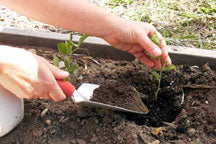 Sweet peas need a spot in full sun with very well drained, rich soil and good air circulation to prevent mildew. If your soil is has a lot of clay, it's critical to work in lots of extra organic material for better drainage. If the soil is very soggy, consider raised beds for good results.
Sweet peas need a spot in full sun with very well drained, rich soil and good air circulation to prevent mildew. If your soil is has a lot of clay, it's critical to work in lots of extra organic material for better drainage. If the soil is very soggy, consider raised beds for good results.If you know that summer weather gets hot very quickly, sow your sweet peas in a location that will get some afternoon shade. Read the seed packet instructions carefully, because proper spacing of plants is important for good results. Seedlings should be protected from slugs and snails. If marauding seed and seedling eating birds are problem, use netting suspended over seedlings until they are 4 to 5 inches tall.
A critical factor for all sweet peas is adequate water. Be sure to water germinating seeds, seedlings, and actively growing mature vines regularly if summer rain is not adequate to keep them evenly moist. If you put your finger into the soil bed to its first joint and the soil is dry: water them.
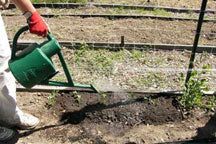 Sweet peas are heavy feeders, so amend soil well before planting with lots of rich compost or well-rotted manure. During the growing season, fertilize at least twice with a good soil drench of tablespoon each of fish emulsion and liquid kelp per gallon of water. (Sweet peas grown in containers will need regular fertilization every few weeks.)
Sweet peas are heavy feeders, so amend soil well before planting with lots of rich compost or well-rotted manure. During the growing season, fertilize at least twice with a good soil drench of tablespoon each of fish emulsion and liquid kelp per gallon of water. (Sweet peas grown in containers will need regular fertilization every few weeks.)Sweet peas can be susceptible to aphids – wash them off with regular blasts of water. Thrips, an occasional problem, can be effectively controlled with sticky pheromone traps that are interspaced amongst the vines to attract and trap them. Good air circulation and avoiding watering in the late afternoon and evening will help prevent mildew ( until the plants succumb to it naturally at the end of their bloom period.)
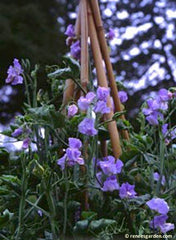 All the tall vining varieties will climb naturally on just about any vertical support system. They will grow up strings, netting, wire or wooden fencing, or just about any kind of trellis. You can also use tall branches left over from tree pruning driven into the soil. Since the tendrils cannot twine around thick poles like bamboo, wrap twine or netting around them so tendrils can grip. In very hot areas like Texas, it's probably best to avoid wire fencing. Erect your well anchored supports before you plant the seeds or when they are a few inches tall.
All the tall vining varieties will climb naturally on just about any vertical support system. They will grow up strings, netting, wire or wooden fencing, or just about any kind of trellis. You can also use tall branches left over from tree pruning driven into the soil. Since the tendrils cannot twine around thick poles like bamboo, wrap twine or netting around them so tendrils can grip. In very hot areas like Texas, it's probably best to avoid wire fencing. Erect your well anchored supports before you plant the seeds or when they are a few inches tall.
Sweet pea seeds will germinate in a range from 75 to 85%. There is always a small percentage that are dormant, allowing Mother Nature a safety zone in the wild if weather conditions are poor. To leave out the dormant seeds, soak the seeds no more than overnight in tap water before planting and only plant the ones that have swelled. For the very best germination rates, do not soak, but nick the seeds to allow moisture to enter the seed coat. To do this, use nail clippers to simply make a small slice in the outside seed coating – no need to gouge out a piece, just allow an opening for moisture to enter naturally. This nicking process takes some extra time but it will guarantee great germination.
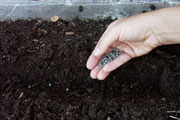 Sow seeds 1 inch deep and two to 3 inches apart. Seeds take anywhere from 10 to 28 days to germinate completely, depending on weather and soil temperature. If your sweet peas do not germinate well, dig down to see if the seeds are still there. If they have rotted or been eaten, plant more right away as they will catch up quickly. When seedlings are several inches tall, it's very important to thin seedlings to stand about 5- 6 inches apart so that plants have room to grow and mature. When seedlings have three or four sets of leaves, pinch off the top set to encourage plants to branch out. Keep sweet pea vines evenly moist, avoiding big shifts in soil moisture during active growing. Mulching is a good strategy.
Sow seeds 1 inch deep and two to 3 inches apart. Seeds take anywhere from 10 to 28 days to germinate completely, depending on weather and soil temperature. If your sweet peas do not germinate well, dig down to see if the seeds are still there. If they have rotted or been eaten, plant more right away as they will catch up quickly. When seedlings are several inches tall, it's very important to thin seedlings to stand about 5- 6 inches apart so that plants have room to grow and mature. When seedlings have three or four sets of leaves, pinch off the top set to encourage plants to branch out. Keep sweet pea vines evenly moist, avoiding big shifts in soil moisture during active growing. Mulching is a good strategy.
 The best way to have the longest season of glorious bloom is to pick bouquets early and often – the more you pick the more flowers you will have and the later the plants will go to seed and die back. Harvest stems of blossoms often when the lowest blossom on each stem just beginning to open. As the season progresses, stems will become shorter, but flowers are still full-size and lovely.
The best way to have the longest season of glorious bloom is to pick bouquets early and often – the more you pick the more flowers you will have and the later the plants will go to seed and die back. Harvest stems of blossoms often when the lowest blossom on each stem just beginning to open. As the season progresses, stems will become shorter, but flowers are still full-size and lovely.
Sweet Peas Species
The annual species Lathyrus odoratus is our common garden sweet pea: you'll find them with different growing habits and colors:
Tall Vining Varieties – these vigorous vines reach 5 to 10 feet tall with many stems of blossoms over a six to eight week bloom period, depending on climate and season variables. There are several flower forms in tall vining varieties:
Old-fashioned or heirloom grandiflora varieties, dating from the late 19th century, have small petalled , dainty flowers in a wide variety of named shades and bicolors. All are very fragrant and have developed a reputation of being more heat tolerant, although I have not found this to be true in our trial garden. Renee's Garden offers "Perfume Delight," "Queen of the Night," "Queen of Hearts," and "Jewels of Albion."
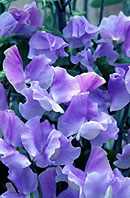 Tall vining "Spencer" varieties, with larger, waved and ruffled elegant blossoms have been the subject of intense breeding efforts in England. Some Spencers are very fragrant; others just mildly so, as English breeders traditionally have been more interested in petal shape, form, stem length and color, rather than in scent or weather tolerance. Most large petalled, ruffled sweet pea varieties can be called Spencer types these days. We carry "Blue Celeste," a fragrant Spencer type.
Tall vining "Spencer" varieties, with larger, waved and ruffled elegant blossoms have been the subject of intense breeding efforts in England. Some Spencers are very fragrant; others just mildly so, as English breeders traditionally have been more interested in petal shape, form, stem length and color, rather than in scent or weather tolerance. Most large petalled, ruffled sweet pea varieties can be called Spencer types these days. We carry "Blue Celeste," a fragrant Spencer type.
American varieties bred in the mid-to late 20th century with good-sized flowers, moderate scent and wide availability include Mammoth and Royals. We do not offer these types, as we specialize only in scented sweet peas.
 Over the last 25 years, well-known flower breeder Dr. Keith Hammett in New Zealand has developed wonderful sweet pea cultivars that combine the weather tolerance and haunting perfume of old-fashioned types with Spencers larger blossom size and beautiful ruffled form. Renee's Garden specializes in offering these cultivars to home gardeners. Our Hammet varieties include: "April in Paris," "North Shore," "Saltwater Taffy Swirls," "Regal Robe," "Royal Wedding," "Watermelon," and "Cupani’s Original."
Over the last 25 years, well-known flower breeder Dr. Keith Hammett in New Zealand has developed wonderful sweet pea cultivars that combine the weather tolerance and haunting perfume of old-fashioned types with Spencers larger blossom size and beautiful ruffled form. Renee's Garden specializes in offering these cultivars to home gardeners. Our Hammet varieties include: "April in Paris," "North Shore," "Saltwater Taffy Swirls," "Regal Robe," "Royal Wedding," "Watermelon," and "Cupani’s Original."
 Containers and Window Box Varieties – These diminutive plants with 8- 10 inch stems or mounding and spreading habits do not need supports and are lovely in pots. We offer the heirloom varieties "Windowbox Cupid" and "Cupid Color Palette."
Containers and Window Box Varieties – These diminutive plants with 8- 10 inch stems or mounding and spreading habits do not need supports and are lovely in pots. We offer the heirloom varieties "Windowbox Cupid" and "Cupid Color Palette."The Elegance series were developed by Bodger seed in Lompoc, California for the cut flower market. These are the earliest blooming sweet peas available, often showing color at least several weeks before other varieties. Unfortunately many Elegance sweet peas are not particularly fragrant. Renee’s Garden carries Chiffon Elegance and Velvet Elegance.
Short, Nonclimbing Dwarfs – These are short sweet peas, some without tendrils, which do not need vertical supports. Ours is "Explorer."
Other Species of Sweet Peas:
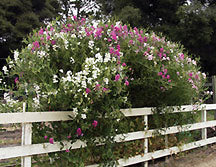 The perennial, Lathyrus latifolius, is often seen as a naturalized roadside wildflower throughout the west. The cultivated form of this perennial can be trained as an attractive and reliable perennial hedge plant which is much more drought tolerant than annual sweet peas. The flowers are simple, small and unscented, but the shape reminds me of little orchids. They are available in shell pink, pure white and rose. We sell this mixture colors as "Garden Orchids." At Sweet Pea Gardens in Surrey, Maine, in zone 4, Susan Keating has planted perennial sweet peas as a tall blooming screen on the side of her garage where they are reliably hardy and over 10 years old. Their stems of bloom also make very pretty bouquet flowers.
The perennial, Lathyrus latifolius, is often seen as a naturalized roadside wildflower throughout the west. The cultivated form of this perennial can be trained as an attractive and reliable perennial hedge plant which is much more drought tolerant than annual sweet peas. The flowers are simple, small and unscented, but the shape reminds me of little orchids. They are available in shell pink, pure white and rose. We sell this mixture colors as "Garden Orchids." At Sweet Pea Gardens in Surrey, Maine, in zone 4, Susan Keating has planted perennial sweet peas as a tall blooming screen on the side of her garage where they are reliably hardy and over 10 years old. Their stems of bloom also make very pretty bouquet flowers.

Lathyrus sativus azureus-this little sweet pea has 1 inch glowing azure-blue flowers and tangled grassy foliage and plants grow just 3 to 4 feet tall. Nice garden accents with short supports in pots. We sell the cultivar "Electric Blue."
Dr. Hammett is working on stabilizing crosses of the different annual species to combine beautiful form and fragrance with new colors and heat tolerance. The next 10 years will offer some exciting new developments for home gardeners, including nonfading orange and apricot hues as well as true tricolor sweet peas, all with intense fragrance.
Sweet Peas in Containers
 Growing short, mounding varieties of sweet peas like "Color Palette" enable gardeners with patios and decks or just small gardening spaces to enjoy their beauty and delightful fragrance. These diminutive vines grow just 8-10 inches with sweetly scented flowers on softly cascading branches. Colors include a rose-pink and white bicolor and a mix of, lavender, pink, dark purple, and mahogany. In very early spring, plant seeds directly in deep containers at least 8 inches in diameter or rectangular window boxes at least 6 inches deep. Always fill planting containers with evenly pre-moistened, good-quality, fresh potting soil before planting seeds 1 inch deep and 3 inches apart. Keep evenly moist and in full sun – germination takes 10-28 days.
Growing short, mounding varieties of sweet peas like "Color Palette" enable gardeners with patios and decks or just small gardening spaces to enjoy their beauty and delightful fragrance. These diminutive vines grow just 8-10 inches with sweetly scented flowers on softly cascading branches. Colors include a rose-pink and white bicolor and a mix of, lavender, pink, dark purple, and mahogany. In very early spring, plant seeds directly in deep containers at least 8 inches in diameter or rectangular window boxes at least 6 inches deep. Always fill planting containers with evenly pre-moistened, good-quality, fresh potting soil before planting seeds 1 inch deep and 3 inches apart. Keep evenly moist and in full sun – germination takes 10-28 days.

When seedlings are 2 inches tall, be sure to thin them to 4 inches apart, (so, for example, you would leave 4-5 evenly spaced plants in a 12 inch in diameter container.) This gives plants room to grow and spread as they mature. It's critical to keep container sweet peas well- watered and remember to fertilize them regularly every two weeks. Protect plants from slugs and snails. For longest bloom, remove faded blossoms regularly. When summer heats up, mulch your containers and give them afternoon shade to prolong their bloom.
 Sweet peas have a long and fascinating horticultural history. In 1699, a botanizing monk, Father Cupani first harvested sweet peas in the wild on an island off the coast of Sicily. In the 19th century, an Englishman named Eckford began hybridizing and selecting sweet peas, introducing larger varieties in a wider range of colors. These "grandifloras" were widely acclaimed as cut flowers, and they are the type of sweet peas we now call "old-fashioned" or "heirloom."
Sweet peas have a long and fascinating horticultural history. In 1699, a botanizing monk, Father Cupani first harvested sweet peas in the wild on an island off the coast of Sicily. In the 19th century, an Englishman named Eckford began hybridizing and selecting sweet peas, introducing larger varieties in a wider range of colors. These "grandifloras" were widely acclaimed as cut flowers, and they are the type of sweet peas we now call "old-fashioned" or "heirloom."During this period, American seed producers who were growing sweet pea seeds for export to the English market and for American seed catalogs also developed cultivars better suited to American garden conditions. The cool, mild and windy coastal area near Lompoc, California is ideally suited for sweet pea production, because the weather keeps the bees that ordinarily visit sweet peas inactive so flowers don't get cross pollinated and seed strains can be kept very pure. Much of the world's sweet pea seed is still produced in that area today as well as in England, New Zealand, and Tasmania.
Given the proper conditions and planting times, you will find sweet peas tremendously rewarding. Unfortunately, sweet peas have had a reputation of being difficult to grow, particularly in the Midwest and Southeast, but in talking to successful sweet pea gardeners nationwide for many years, I am sure that sweet peas can be successful all over the country. In those few areas where they are more challenging, their beauty and fragrance are well worth the effort! The important thing is knowing when to plant the seeds and how to care for sweet peas properly.
When To Plant Sweet Pea Seeds
 In mild winter areas, where the summers are hot but the ground does not freeze in winter, sow sweet pea seeds at the same time you plant your fall bulbs – roughly from October through early November or as soon as the weather cools down, but rains haven’t started. This is what we do here in Northern California. In these conditions, the seeds will germinate and develop strong root systems but not show much top growth. In early spring, longer day length brings on rapid growth and the vines shoot up. Organic grower Judy Barrett, who writes the excellent newsletter Home Grown for organic gardeners in Austin, Texas also reminded me that if winters are dry in your area, do not forget to water your sweet pea seedlings and provide some afternoon shade in very hot areas of Texas and Florida. If you miss the chance to plant in the fall, sow seeds in mid-January or February.
In mild winter areas, where the summers are hot but the ground does not freeze in winter, sow sweet pea seeds at the same time you plant your fall bulbs – roughly from October through early November or as soon as the weather cools down, but rains haven’t started. This is what we do here in Northern California. In these conditions, the seeds will germinate and develop strong root systems but not show much top growth. In early spring, longer day length brings on rapid growth and the vines shoot up. Organic grower Judy Barrett, who writes the excellent newsletter Home Grown for organic gardeners in Austin, Texas also reminded me that if winters are dry in your area, do not forget to water your sweet pea seedlings and provide some afternoon shade in very hot areas of Texas and Florida. If you miss the chance to plant in the fall, sow seeds in mid-January or February.
In mild winter areas that have long wet winters with cool summers, like the Pacific Northwest, you can plant sweet peas in the fall and again in the spring. Seattle gardener (and our webmaster) Sue sows seeds in April or May for "armfuls of blooms" through September!
In moderate winter areas, such as the mid-Atlantic states, with humid summers and early, unpredictable summer heat, plant seeds very, very early – as soon as the ground is workable – in rich, well-drained soil. Don't wait until your last frost date (sweet peas can tolerate light frosts) or until you plant other annual flowers such as sunflowers or cosmos. Your sweet peas won't be mature enough to handle early high summer temperatures. Be sure to water your sweet pea plants if it doesn't rain, as they need regular moisture.
To get this early start and also deal with unpredictable spring weather, Virginia market gardener Nancy Hammer starts seeds indoors in jumbo packs or 4 inch pots indoors in late March to plant out as soon as they have two or three pairs of leaves. She also puts seeds directly in the ground in early to mid April. That way, whether it's cold and rainy well into spring or if hot weather hits suddenly she's prepared with good strong seedlings.
In very cold winter areas, as in New England, where the ground freezes hard and heaves, both Susan Keating in Maine and Jay Leshinsky in Vermont wait until the spring soil can be easily worked before planting, usually in late April through mid May. They also get a head start by sowing seeds indoors a month to six weeks early, to plant out as soon as possible when weather permits, all the way through May. Either way, remember that late mild frosts do not hamper sweet peas. In northern areas, sweet peas planted out in April and May will reach full bloom in late summer and continue almost until the first frost. Pick a spot where vines will get some afternoon shade if summers get very hot, and water if it doesn't rain.
For additional help, view our photo guides: Sowing Sweet Pea Seeds Directly in the Garden and Starting Sweet Pea Seeds Early and Transplanting Seedlings.
Growing Sweet Peas
 Sweet peas need a spot in full sun with very well drained, rich soil and good air circulation to prevent mildew. If your soil is has a lot of clay, it's critical to work in lots of extra organic material for better drainage. If the soil is very soggy, consider raised beds for good results.
Sweet peas need a spot in full sun with very well drained, rich soil and good air circulation to prevent mildew. If your soil is has a lot of clay, it's critical to work in lots of extra organic material for better drainage. If the soil is very soggy, consider raised beds for good results.If you know that summer weather gets hot very quickly, sow your sweet peas in a location that will get some afternoon shade. Read the seed packet instructions carefully, because proper spacing of plants is important for good results. Seedlings should be protected from slugs and snails. If marauding seed and seedling eating birds are problem, use netting suspended over seedlings until they are 4 to 5 inches tall.
A critical factor for all sweet peas is adequate water. Be sure to water germinating seeds, seedlings, and actively growing mature vines regularly if summer rain is not adequate to keep them evenly moist. If you put your finger into the soil bed to its first joint and the soil is dry: water them.
 Sweet peas are heavy feeders, so amend soil well before planting with lots of rich compost or well-rotted manure. During the growing season, fertilize at least twice with a good soil drench of tablespoon each of fish emulsion and liquid kelp per gallon of water. (Sweet peas grown in containers will need regular fertilization every few weeks.)
Sweet peas are heavy feeders, so amend soil well before planting with lots of rich compost or well-rotted manure. During the growing season, fertilize at least twice with a good soil drench of tablespoon each of fish emulsion and liquid kelp per gallon of water. (Sweet peas grown in containers will need regular fertilization every few weeks.)Sweet peas can be susceptible to aphids – wash them off with regular blasts of water. Thrips, an occasional problem, can be effectively controlled with sticky pheromone traps that are interspaced amongst the vines to attract and trap them. Good air circulation and avoiding watering in the late afternoon and evening will help prevent mildew ( until the plants succumb to it naturally at the end of their bloom period.)
 All the tall vining varieties will climb naturally on just about any vertical support system. They will grow up strings, netting, wire or wooden fencing, or just about any kind of trellis. You can also use tall branches left over from tree pruning driven into the soil. Since the tendrils cannot twine around thick poles like bamboo, wrap twine or netting around them so tendrils can grip. In very hot areas like Texas, it's probably best to avoid wire fencing. Erect your well anchored supports before you plant the seeds or when they are a few inches tall.
All the tall vining varieties will climb naturally on just about any vertical support system. They will grow up strings, netting, wire or wooden fencing, or just about any kind of trellis. You can also use tall branches left over from tree pruning driven into the soil. Since the tendrils cannot twine around thick poles like bamboo, wrap twine or netting around them so tendrils can grip. In very hot areas like Texas, it's probably best to avoid wire fencing. Erect your well anchored supports before you plant the seeds or when they are a few inches tall.
Sweet pea seeds will germinate in a range from 75 to 85%. There is always a small percentage that are dormant, allowing Mother Nature a safety zone in the wild if weather conditions are poor. To leave out the dormant seeds, soak the seeds no more than overnight in tap water before planting and only plant the ones that have swelled. For the very best germination rates, do not soak, but nick the seeds to allow moisture to enter the seed coat. To do this, use nail clippers to simply make a small slice in the outside seed coating – no need to gouge out a piece, just allow an opening for moisture to enter naturally. This nicking process takes some extra time but it will guarantee great germination.
 Sow seeds 1 inch deep and two to 3 inches apart. Seeds take anywhere from 10 to 28 days to germinate completely, depending on weather and soil temperature. If your sweet peas do not germinate well, dig down to see if the seeds are still there. If they have rotted or been eaten, plant more right away as they will catch up quickly. When seedlings are several inches tall, it's very important to thin seedlings to stand about 5- 6 inches apart so that plants have room to grow and mature. When seedlings have three or four sets of leaves, pinch off the top set to encourage plants to branch out. Keep sweet pea vines evenly moist, avoiding big shifts in soil moisture during active growing. Mulching is a good strategy.
Sow seeds 1 inch deep and two to 3 inches apart. Seeds take anywhere from 10 to 28 days to germinate completely, depending on weather and soil temperature. If your sweet peas do not germinate well, dig down to see if the seeds are still there. If they have rotted or been eaten, plant more right away as they will catch up quickly. When seedlings are several inches tall, it's very important to thin seedlings to stand about 5- 6 inches apart so that plants have room to grow and mature. When seedlings have three or four sets of leaves, pinch off the top set to encourage plants to branch out. Keep sweet pea vines evenly moist, avoiding big shifts in soil moisture during active growing. Mulching is a good strategy.
 The best way to have the longest season of glorious bloom is to pick bouquets early and often – the more you pick the more flowers you will have and the later the plants will go to seed and die back. Harvest stems of blossoms often when the lowest blossom on each stem just beginning to open. As the season progresses, stems will become shorter, but flowers are still full-size and lovely.
The best way to have the longest season of glorious bloom is to pick bouquets early and often – the more you pick the more flowers you will have and the later the plants will go to seed and die back. Harvest stems of blossoms often when the lowest blossom on each stem just beginning to open. As the season progresses, stems will become shorter, but flowers are still full-size and lovely.
Sweet Peas Species
The annual species Lathyrus odoratus is our common garden sweet pea: you'll find them with different growing habits and colors:
Tall Vining Varieties – these vigorous vines reach 5 to 10 feet tall with many stems of blossoms over a six to eight week bloom period, depending on climate and season variables. There are several flower forms in tall vining varieties:
Old-fashioned or heirloom grandiflora varieties, dating from the late 19th century, have small petalled , dainty flowers in a wide variety of named shades and bicolors. All are very fragrant and have developed a reputation of being more heat tolerant, although I have not found this to be true in our trial garden. Renee's Garden offers "Perfume Delight," "Queen of the Night," "Queen of Hearts," and "Jewels of Albion."
 Tall vining "Spencer" varieties, with larger, waved and ruffled elegant blossoms have been the subject of intense breeding efforts in England. Some Spencers are very fragrant; others just mildly so, as English breeders traditionally have been more interested in petal shape, form, stem length and color, rather than in scent or weather tolerance. Most large petalled, ruffled sweet pea varieties can be called Spencer types these days. We carry "Blue Celeste," a fragrant Spencer type.
Tall vining "Spencer" varieties, with larger, waved and ruffled elegant blossoms have been the subject of intense breeding efforts in England. Some Spencers are very fragrant; others just mildly so, as English breeders traditionally have been more interested in petal shape, form, stem length and color, rather than in scent or weather tolerance. Most large petalled, ruffled sweet pea varieties can be called Spencer types these days. We carry "Blue Celeste," a fragrant Spencer type.
American varieties bred in the mid-to late 20th century with good-sized flowers, moderate scent and wide availability include Mammoth and Royals. We do not offer these types, as we specialize only in scented sweet peas.
 Over the last 25 years, well-known flower breeder Dr. Keith Hammett in New Zealand has developed wonderful sweet pea cultivars that combine the weather tolerance and haunting perfume of old-fashioned types with Spencers larger blossom size and beautiful ruffled form. Renee's Garden specializes in offering these cultivars to home gardeners. Our Hammet varieties include: "April in Paris," "North Shore," "Saltwater Taffy Swirls," "Regal Robe," "Royal Wedding," "Watermelon," and "Cupani’s Original."
Over the last 25 years, well-known flower breeder Dr. Keith Hammett in New Zealand has developed wonderful sweet pea cultivars that combine the weather tolerance and haunting perfume of old-fashioned types with Spencers larger blossom size and beautiful ruffled form. Renee's Garden specializes in offering these cultivars to home gardeners. Our Hammet varieties include: "April in Paris," "North Shore," "Saltwater Taffy Swirls," "Regal Robe," "Royal Wedding," "Watermelon," and "Cupani’s Original."
 Containers and Window Box Varieties – These diminutive plants with 8- 10 inch stems or mounding and spreading habits do not need supports and are lovely in pots. We offer the heirloom varieties "Windowbox Cupid" and "Cupid Color Palette."
Containers and Window Box Varieties – These diminutive plants with 8- 10 inch stems or mounding and spreading habits do not need supports and are lovely in pots. We offer the heirloom varieties "Windowbox Cupid" and "Cupid Color Palette."The Elegance series were developed by Bodger seed in Lompoc, California for the cut flower market. These are the earliest blooming sweet peas available, often showing color at least several weeks before other varieties. Unfortunately many Elegance sweet peas are not particularly fragrant. Renee’s Garden carries Chiffon Elegance and Velvet Elegance.
Short, Nonclimbing Dwarfs – These are short sweet peas, some without tendrils, which do not need vertical supports. Ours is "Explorer."
Other Species of Sweet Peas:
 The perennial, Lathyrus latifolius, is often seen as a naturalized roadside wildflower throughout the west. The cultivated form of this perennial can be trained as an attractive and reliable perennial hedge plant which is much more drought tolerant than annual sweet peas. The flowers are simple, small and unscented, but the shape reminds me of little orchids. They are available in shell pink, pure white and rose. We sell this mixture colors as "Garden Orchids." At Sweet Pea Gardens in Surrey, Maine, in zone 4, Susan Keating has planted perennial sweet peas as a tall blooming screen on the side of her garage where they are reliably hardy and over 10 years old. Their stems of bloom also make very pretty bouquet flowers.
The perennial, Lathyrus latifolius, is often seen as a naturalized roadside wildflower throughout the west. The cultivated form of this perennial can be trained as an attractive and reliable perennial hedge plant which is much more drought tolerant than annual sweet peas. The flowers are simple, small and unscented, but the shape reminds me of little orchids. They are available in shell pink, pure white and rose. We sell this mixture colors as "Garden Orchids." At Sweet Pea Gardens in Surrey, Maine, in zone 4, Susan Keating has planted perennial sweet peas as a tall blooming screen on the side of her garage where they are reliably hardy and over 10 years old. Their stems of bloom also make very pretty bouquet flowers.

Lathyrus sativus azureus-this little sweet pea has 1 inch glowing azure-blue flowers and tangled grassy foliage and plants grow just 3 to 4 feet tall. Nice garden accents with short supports in pots. We sell the cultivar "Electric Blue."
Dr. Hammett is working on stabilizing crosses of the different annual species to combine beautiful form and fragrance with new colors and heat tolerance. The next 10 years will offer some exciting new developments for home gardeners, including nonfading orange and apricot hues as well as true tricolor sweet peas, all with intense fragrance.
Sweet Peas in Containers
 Growing short, mounding varieties of sweet peas like "Color Palette" enable gardeners with patios and decks or just small gardening spaces to enjoy their beauty and delightful fragrance. These diminutive vines grow just 8-10 inches with sweetly scented flowers on softly cascading branches. Colors include a rose-pink and white bicolor and a mix of, lavender, pink, dark purple, and mahogany. In very early spring, plant seeds directly in deep containers at least 8 inches in diameter or rectangular window boxes at least 6 inches deep. Always fill planting containers with evenly pre-moistened, good-quality, fresh potting soil before planting seeds 1 inch deep and 3 inches apart. Keep evenly moist and in full sun – germination takes 10-28 days.
Growing short, mounding varieties of sweet peas like "Color Palette" enable gardeners with patios and decks or just small gardening spaces to enjoy their beauty and delightful fragrance. These diminutive vines grow just 8-10 inches with sweetly scented flowers on softly cascading branches. Colors include a rose-pink and white bicolor and a mix of, lavender, pink, dark purple, and mahogany. In very early spring, plant seeds directly in deep containers at least 8 inches in diameter or rectangular window boxes at least 6 inches deep. Always fill planting containers with evenly pre-moistened, good-quality, fresh potting soil before planting seeds 1 inch deep and 3 inches apart. Keep evenly moist and in full sun – germination takes 10-28 days.

When seedlings are 2 inches tall, be sure to thin them to 4 inches apart, (so, for example, you would leave 4-5 evenly spaced plants in a 12 inch in diameter container.) This gives plants room to grow and spread as they mature. It's critical to keep container sweet peas well- watered and remember to fertilize them regularly every two weeks. Protect plants from slugs and snails. For longest bloom, remove faded blossoms regularly. When summer heats up, mulch your containers and give them afternoon shade to prolong their bloom.



